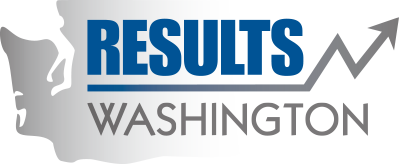Archived: Travel and Freight Reliability on Strategic Corridors
Data source: Washington State Department of Transportation
The original measure used 2012 data as a baseline; as of April 2017, the measure is based on a three-year rolling average of the reliability index.
The top graph shows the reliability index for 5 a.m. to 8 p.m. for 26 key commute routes in the central Puget Sound region. The reliability index is the 80th percentile reliable travel time divided by the maximum throughput travel time. The 80th percentile travel time will ensure the traveler is on time four out of five weekday trips. Maximum throughput travel time is defined as the amount of time that it would take to travel the length of a corridor at maximum throughput speed (the speed at which the system operates at peak efficiency). The bottom graph shows the reliability index for morning and evening peak periods (5-10 a.m. and 2-8 p.m., respectively). A reliability index greater than 1 indicates that the system is congested; an increase in the index over time indicates worsening congestion and less reliable travel times. More information on how the reliability index is calculated can be accessed in the following background document .
NO INFORMATION
Washington state depends on its roadways to reliably move people and goods. Reliability is an important metric for highway users because it provides information that allows travelers to plan for on-time arrival with a higher degree of certainty. Commuters can plan the daily trips to work during peak hours, parents can plan the afternoon run to the daycare center, businesses know when a just-in-time shipment must leave the factory, and transit agencies can develop reliable schedules. Shippers and freight carriers require predictable travel times to remain competitive. Maintaining reliable travel times for people and freight movement is important to the region's economic vitality.
For 2015, WSDOT did not meet the goal of maintaining travel and freight reliability to no more than 5% above the 2012 baseline. Travel time reliability in 2015 has worsened 8.1% from 2012 levels. Travel time reliability has been worsening since 2009, which follows the overall trend of economic growth. Reliable travel times are impacted by economic activity because more people and freight movement often means more traffic on the roads. More traffic can result in increased delay related to congestion and unexpected delay, such as accidents. Reliable travel time indicators show the best performance in 2009. This corresponds with a decline in economic activity during the Great Recession, meaning less traffic on the roadways.
- Practical solutions: WSDOT is actively implementing Practical Solutions, a two-part strategy that includes Least Cost Planning initiatives and Practical Design, which enables more flexible and sustainable transportation investment decisions. This includes initiatives to improve person throughput and trip reliability. Using Practical Solutions principles, planners and engineers can develop solutions specific to a performance goal (such as travel time reliability and improved throughput) that are strategic and incremental without compromising safety. This approach allows the focus to remain on project need and how it will help meet the core transportation needs, without excessively addressing other performance categories. For example, WSDOT is working with partners to create a corridor sketch database with consistent baseline information about each transportation corridor statewide which will provide functional and performance-oriented corridor descriptions. For more information on WSDOT’s Practical Solutions overview, examples, and FAQs, please visit http://www.wsdot.wa.gov/Projects/PracticalDesign/
- Transportation options: WSDOT is working closely with cities and counties, transit agencies, planning organizations, businesses and other stake holder communities to promote multimodal transportation options. This would emphasize options such as walking, biking, transit, ride share, carpools and teleworking. Providing diverse options for commuters and connecting alternative mode networks can enable capacity on the regional system to improve throughput and travel time reliability.
- Tolling and High Occupancy Toll (HOT) lanes: WSDOT is integrating tolling as a strategic tool to help manage traffic more efficiently, fund public improvement projects, and generate revenue required for ongoing operational costs of existing facilities. WSDOT currently tolls the SR 520 Bridge, Tacoma Narrows Bridge, SR 167 HOT lanes, and I-405 Express Toll Lanes. Express toll lanes and HOT lanes benefit transit, vanpools, carpools, and motorcycles with more reliability and give other drivers the new option to pay a toll to access a faster trip. Toll lanes save people time, improve lane performance, and help move more people and vehicles through a corridor at peak hours. Dynamic pricing is used on the SR 167 HOT lanes and I-405 Express Toll Lanes. A computer algorithm changes the toll rate in response to traffic volumes and speeds, increasing the toll rate during congestion in order to manage traffic volume and keep traffic moving.
NO INFORMATION
